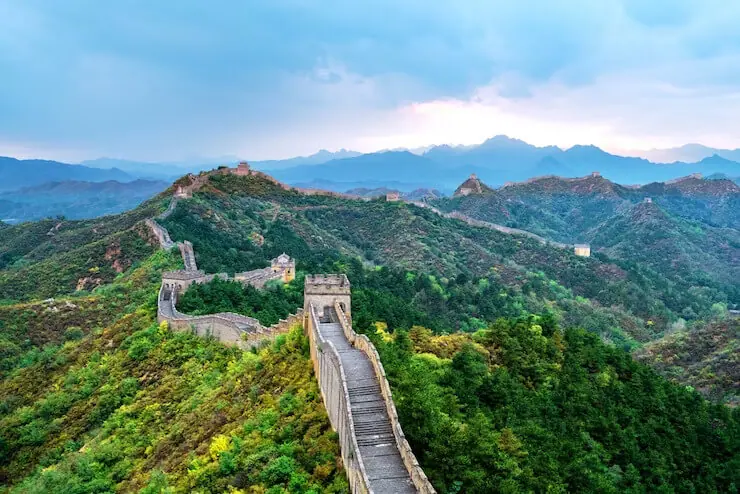Updated May 25, 2023
Historical Border of China
The Great Wall of China can be seen only in China. It stretches 13,000 miles from the snow-covered deserts in the west to the yellow sea. The Great Wall is the most extended structure ever built by humans. Like the Silk route, the Great Wall of China isn’t just a single wonder but many. Built with super-strong clay bricks, the Great Wall of China started small, and as new dynasties took over, they modified and strengthened it as we know it now. In this article, you will dive deep into the history of the Great Wall Of China and understand why it’s one of the most sought-after spots by tourists.
History of the Great Wall of China
The Great Wall of China symbolizes the complex history of China. Most people mistake it as a single wall, but many different walls and fortifications have been built over thousands of years. The purpose of these walls was to protect China against invasion. Here are a few more points about the history of the Great Wall:
- The earliest wall had built about 2000 years ago when states built walls made of gravel to protect their boundaries.
- In 221 BC, China’s first emperor, Qin Shi Huang, ordered the destruction of those existing walls and built a new wall using those pieces.
- The first walls have now fallen into ruins, but the subsequent ruling dynasties constructed them using more robust materials, ensuring their preservation today.
- Each dynasty constructed, repaired and expanded the walls.
- The leaders of the Ming Dynasty in 1308 constructed the most famous versions of the Great Wall, which includes watchtowers and garrisons made of stones. By the end of 1644, 25,000 watch towers had been just built.
- The newer wall versions still stand tall as they were with much sturdier materials like brick and mortar.
Why was The Great Wall of China Built?
The current Great Wall was once a battleground between the Chinese and raiders from modern Mongolia, known as the Xiongnu. To pursue or engage with them would often result in disaster. With their excellent horse riding skills and a deadly composite now, they revolutionized warfare and forced the great Chinese to adopt a new radical strategy.
The Chinese decided that building a Wall would serve the purpose of defending them from the nomads. Though it was challenging to make the Wall, the Chinese managed to do so and were able to protect their territories.
Architecture and Design of the Great Wall of China
The mighty Stone structures near Beijing may come to mind when you think of the Wall, but those they built later. During the initial construction of the Great Wall, it primarily relied on local resources, resulting in a much simpler design. For example, when building across plains, they used rammed earth; in the desert, they mixed native plants into the sand and gravel to add fiber support; and when building along mountains, they used stones from those mountains. Because the mortar was surprisingly sturdy, the more recent sections remain intact while, the older ones have largely eroded.
What is there to do at the Great Wall of China?
Apart from just walking or hiking the Great Wall, there’s a lot more stuff to do, like:
- Walk the Great Wall at night when it is lit up between the 5th and 6th watchtowers
- Go camping during Autumn
- Have a picnic if you enjoy the outdoors
- Get down from the Great Wall on a Toboggan
- Under reasonable weather conditions, you could go on a helicopter to view the Great Wall
- Run the “Huangyaguan Great Wall Marathon” if you’re up for some challenge.
Interesting Facts
Here are some interesting facts about the Great Wall that you may or may not know:
- The Wall is so long that when the sun would rise, the guards at the east end of the Wall would witness it 1 hour 20 minutes before the guards at the west end.
- Almost ⅓rd of the Wall has eroded
- The Wall primarily served as a defensive structure to protect territories while facilitating messages exchange through the beacon towers.
- The Great Wall is technically poisonous as it has Arsenic that had used to keep the Wall from eroding by insects.
- The narrative of “Meng Jiangnu’s Bitter Weeping,” which narrates the tale of a woman whose husband had slain while building the Wall, is the most well-known and widely-accepted tradition of The Great Wall of China. Her sobs were so sour that a portion of the Wall gave apart, allowing her to access her husband’s remains so she could bury him. However, there were no bodies found.
Conclusion
The Great Wall of China is in China and is one of the world’s seven wonders. Using over a billion super-strong clay bricks, builders initially constructed the Great Wall of China on a small scale. Subsequently, new dynasties took charge, modifying and reinforcing it to shape it into its current renowned form. The Chinese build a complex linear fortress Wall using various available materials. The Great Wall still stands tall and is one of the unique structures made by man.



